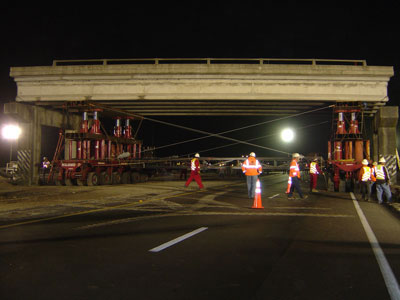U.S. Department of Transportation
Federal Highway Administration
1200 New Jersey Avenue, SE
Washington, DC 20590
202-366-4000
Focus
| Accelerating Infrastructure Innovations |
Publication Number: FHWA-HRT-08-009
Date: December 2007
Printable Version (.pdf, 0.3 mb)
Lift and drive your prefabricated new bridge to its final location in a matter of minutes with the use of self-propelled modular transporters (SPMTs). As the Federal Highway Administration (FHWA) details in its new Manual on Use of Self-Propelled Modular Transporters to Remove and Replace Bridges (Pub. No. FHWA-HIF-07-022), prefabricating bridges offsite under controlled conditions and then rapidly transporting them to their final destination for immediate erection can reduce traffic impacts to a matter of hours or a few days, rather than the months typically required for conventional onsite bridge construction. While in some cases initial construction costs can be higher, the offsetting savings from reduced construction time and user costs can be substantial. Offsite construction also increases worker safety.
SPMTs are multi-axle, computer-controlled platform vehicles that can move bridge systems weighing up to several thousand tons with precision to within a fraction of an inch. The vehicles can move in any horizontal direction and also have vertical lift. "This technology should be considered for all bridge replacement projects where reduced onsite construction time is a priority," says Vasant Mistry of FHWA's Office of Bridge Technology. "More and more States are excited about using SPMTs." Using SPMTs for bridge moves was the top implementation recommendation of the 2004 Prefabricated Bridge Elements and Systems International Scan sponsored by FHWA, the American Association of State Highway and Transportation Officials (AASHTO), and the Transportation Research Board's National Cooperative Highway Research Program (NCHRP). The scan team observed the frequent use of SPMTs in European countries.
The manual includes sections on planning, design, benefits and costs, contracting issues, and contract documents. Among the topics covered are criteria to use in determining when the SPMT technology is appropriate, planning-related issues such as traffic considerations and site requirements, and design issues such as prefabrication requirements and allowable temporary stresses and deflections during the move. Contracting topics featured include staging area requirements and contracting strategies for reducing onsite construction time.
Also included are case studies of States and European countries that have used SPMTs to date, including the Florida Department of Transportation's replacement of the Graves Avenue Bridge in Volusia County in 2006 (see December 2006 Focus). Appendices feature sample plan sheets and specifications, including a sample specification for SPMT equipment and a user cost model spreadsheet.
The manual is the second in FHWA's series of publications on accelerated bridge construction, following the 2006 Framework for Prefabricated Bridge Elements and Systems Decision-Making (Pub. No. FHWA-IF-06-30). It is cosponsored by AASHTO, NCHRP, and the Florida Department of Transportation. "The new manual reflects the continued development of tools that States can use to accelerate their bridge construction," says Benjamin Tang of FHWA's Office of Bridge Technology.
For more information on the use of SPMTs or to obtain a copy of the manual, contact Vasant Mistry at FHWA, 202-366-4599 (email: vasant.mistry@fhwa.dot.gov). The Framework for Prefabricated Bridge Elements and Systems Decision-Making is available online at www.fhwa.dot.gov/bridge/prefab/framework.cfm.
 |
 |
| By using prefabricated bridge elements and SPMTs, the Florida Department of Transportation cut months off the project schedule for constructing the new Graves Avenue bridge in Volusia County in 2006. |